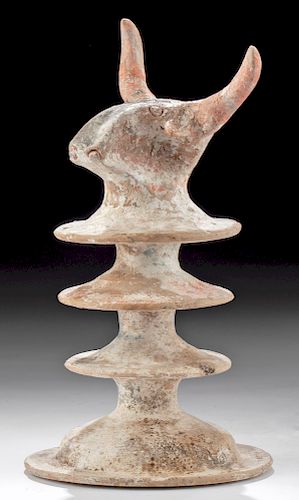Greek Canosan Terracotta Bull Votive w/ Great Pigment
Lot 33
About Seller
Artemis Fine Arts
686 S Taylor Ave, Ste 106
Louisville, CO 80027
United States
Selling antiquities, ancient and ethnographic art online since 1993, Artemis Gallery specializes in Classical Antiquities (Egyptian, Greek, Roman, Near Eastern), Asian, Pre-Columbian, African / Tribal / Oceanographic art. Our extensive inventory includes pottery, stone, metal, wood, glass and textil...Read more
Categories
Estimate:
$1,200 - $1,800
Absentee vs Live bid
Two ways to bid:
- Leave a max absentee bid and the platform will bid on your behalf up to your maximum bid during the live auction.
- Bid live during the auction and your bids will be submitted real-time to the auctioneer.
Bid Increments
| Price | Bid Increment |
|---|---|
| $0 | $25 |
| $300 | $50 |
| $1,000 | $100 |
| $2,000 | $250 |
| $5,000 | $500 |
| $10,000 | $1,000 |
| $20,000 | $2,500 |
| $50,000 | $5,000 |
| $100,000 | $10,000 |
| $200,000 | $20,000 |
About Auction
By Artemis Fine Arts
Feb 13, 2020
Set Reminder
2020-02-13 10:00:00
2020-02-13 10:00:00
America/New_York
Bidsquare
Bidsquare : Exceptional Antiquities, Asian, Ethnographic
https://www.bidsquare.com/auctions/artemis-gallery/exceptional-antiquities-asian-ethnographic-4848
An important one-day auction featuring museum-worthy examples of Egyptian, Greek, Roman, Etruscan, Near Eastern, Far East / Asian, Pre-Columbian, African / Tribal, Oceanic, Native American, Spanish Colonial, Russian, Fossils, Ancient Jewelry, Fine Art, so much more! Artemis Fine Arts info@artemisfinearts.com
An important one-day auction featuring museum-worthy examples of Egyptian, Greek, Roman, Etruscan, Near Eastern, Far East / Asian, Pre-Columbian, African / Tribal, Oceanic, Native American, Spanish Colonial, Russian, Fossils, Ancient Jewelry, Fine Art, so much more! Artemis Fine Arts info@artemisfinearts.com
- Lot Description
Magna Graecia, Apulia, Canosan Hellenistic Period, ca. 3rd century BCE. An intriguing sculpture of a bull's head above a disc-adorned column with a lovely integral pedestal base. Given that the base is concave, with a pronounced, flat rim, this piece may have served as the lid of a vessel designed to hold offerings or burn incense and be placed in a tomb. The bull's head is stylized, with a squared-off snout punctuated by two raised nostrils, long ears, and two large, curved, upright horns. The piece is painted with the characteristic pale white, red, and blue pigments, nice pigmentation is one of the hallmarks of Canosan artists! Size: 6.5" H (16.5 cm)
Canosa was a wealthy city that only grew in importance after the Romans entered the area in the late 4th century BCE. Their ceramic workshops produced items that were exclusively used in funerary contexts, including large vases with extensive applied decoration and incense burners known as thymiateria. The bull motif is known as bucrania, and it was very popular throughout the ancient world, celebrating the ritual religious practice of sacrificing bulls as well as the symbolism of the bull as a virile, powerful animal.
Provenance: private New York City, USA and Paris, France collection, acquired from La Reine Margot, 1970s to 1980s
All items legal to buy/sell under U.S. Statute covering cultural patrimony Code 2600, CHAPTER 14, and are guaranteed to be as described or your money back.
A Certificate of Authenticity will accompany all winning bids.
We ship worldwide and handle all shipping in-house for your convenience.
#152746Horns have been repaired. Fine remaining pigment and form. Nice areas of manganese deposits over surface.Condition
- Shipping Info
-
All shipping is handled in-house for your convenience. Your invoice from Artemis Gallery will include shipping calculation instructions. If in doubt, please inquire BEFORE bidding for estimated shipping costs for individual items.
-
- Buyer's Premium



 EUR
EUR CAD
CAD AUD
AUD GBP
GBP MXN
MXN HKD
HKD CNY
CNY MYR
MYR SEK
SEK SGD
SGD CHF
CHF THB
THB














